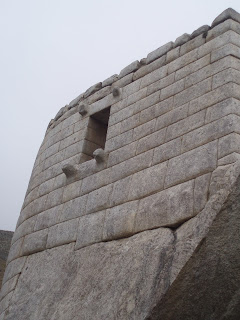










 From Cusco we took a train to Aqua Caliente - a
From Cusco we took a train to Aqua Caliente - asmall tourist town at the
 base of Machu Picchu.
base of Machu Picchu.We awoke to find ourselves at the bottom of narrow valley, surrounded by towering, sheer monolyths, shrouded in clouds. A dramatic start to a breath-taking day! From there we took a twenty minute bus ride up the very steep mountains to Machu Picchu - the ruins of an Inca community.
Interesting facts I gleaned from the guides:
- These ruins circa 1500 AD.
- These ruins were discovered in 1912 by an historian, Hiram Bingham.
- The Inca built these structures within 100 years.
- People did not pay tax, instead they were required to give two months of every year to the building and construction of the community.
- The facility was used by the leaders, nobility and learned people primarily for political and religious purposes. It was a place for learning. People would come from all over South America to study.
- It was also a place of worship. The people worshiped the Sun (the world above - symbolised by the Condor), the Earth (the plant and animals - symbolised by the Puma), and the world below (symbolised by the snake). They would make offerings by sacrificing animals (not people!).
- Pilgims would come to worship - they would bring a stone and food with them as contribution.
- The disciplines taught were: philosophy, medicine, agriculture, astronomy and religion. The women were also taught cooking and the preparation of halucingenic drinks for medical purposes .
- The Spanish did not find this community - the Inca fled when they knew the Spanish were in Cusco, taking their gold and treasures with them.
- About 500 permanent residents lived here.
- The people grew all their food including: avocado, tapioca, chilli, sweet potatoes, passionfruit, papaya, chirimoya, quinoa.
- Agricultural research was a primary focus - acclimatising plants for the high altitude. There are marked temperature differences between the terraces - each suited for a different crop.
- The rocks are granite - hewn by bronze tools as well as sand, water and hammers.
- They built high on this mountain (2860m above sea level) because of: the access to spring water, the abundance of rocks on the mountain, high position (protection from enemies), access to the jungle (special plants-coca), and built near the Inca capital - Cusco.
- The city is fully irrigated - channels carry fresh spring water throughout the housing area and down the terraces.
Off to buy chocolate now!

















 Today, large elaborate cathedrals stand where Inca temples once stood. The city has a charm of its own - a mixture of the old Inca stone work and the Spanish
Today, large elaborate cathedrals stand where Inca temples once stood. The city has a charm of its own - a mixture of the old Inca stone work and the Spanish 








 What do you think of my new man? He´s a beauty!!!!! He´s an Inca! More about him on my next blog!
What do you think of my new man? He´s a beauty!!!!! He´s an Inca! More about him on my next blog!

 Another family at the maket with their llama. The children are eating some fruit (pepinos) that I´d just bought at the market.
Another family at the maket with their llama. The children are eating some fruit (pepinos) that I´d just bought at the market.










